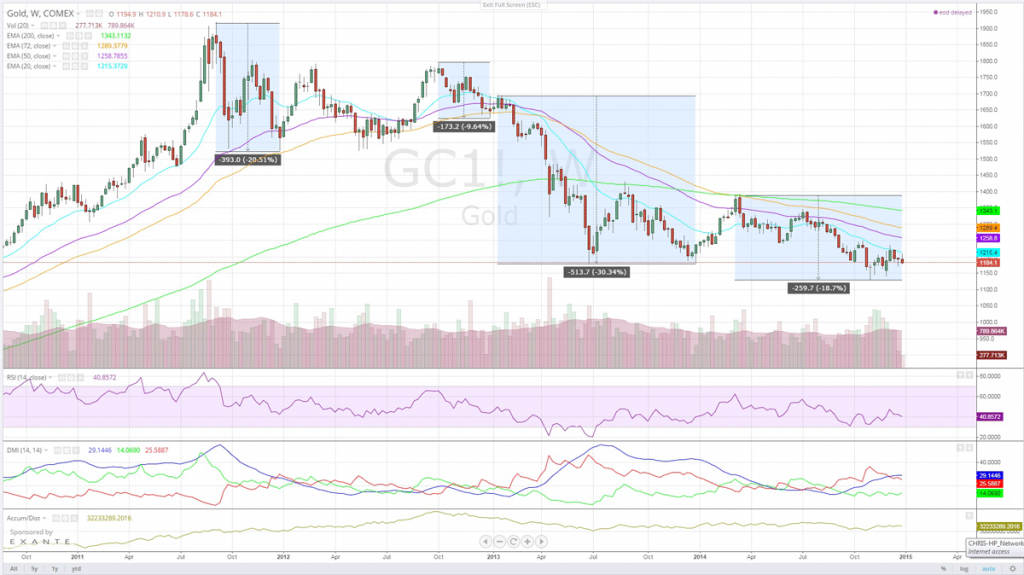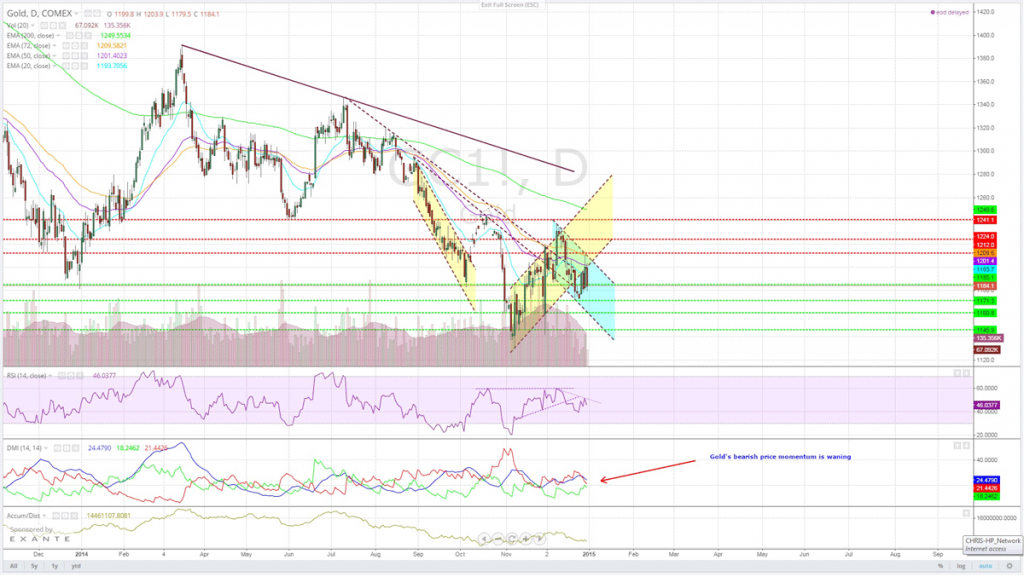Gold ends 2014 modestly lower, while $1,200 remains a key pivot point.
 Bullion.Directory precious metals analysis 1 January, 2015
Bullion.Directory precious metals analysis 1 January, 2015
By Christopher Lemieux
Senior Analyst at Bullion.Directory; Senior FX and Commodities Analyst at FX Analytics
Gold has been rather resilient, in my opinion, to many factors that should have dictated its demise. Even as the yellow metal hit price lows not seen since the Lehman Brothers collapse, gold was virtually unchanged in 2014 – falling less than two percent.
Gold has remained an asset to hate because no matter how it has performed since 2011, the market elite cannot shake the unwavering love gold investors and the financially sensible have for the “premier currency.”
One would think that with US equity markets at all-time highs, gold should be falling into a black hole, yet it is not. In fact a lot of the skepticism comes from gold’s decline from 2011’s high of $1,923.4 per toz. Currently trading at $1,183.9 per toz., gold has corrected almost 39 percent in three-years, with 2013 being the steepest.
Market participants will focus on this as gold falling out of favor, yet US equities have not seen a 10-plus percent correction since gold began to fall. So, which asset class is inflated? Which is poised for further declines?
Lets try to rationalize that the Dow Jones Industrial Average (DJIA) made over 50 new “all-time” highs in 2014 and nearly as many in 2013. As I have said, while learning from my near decade in financial markets, trading (and sometimes investing) defies logic.
Let’s look at gold’s performance from yearly highs and the corresponding correction. Even considering the deep decline in 2013, gold is still up 73 percent since the Fed began its directionless monetary policy.
Gold still has been trading rather technically, opposed to what many may say is fundamentally driven. The US dollar index has remained positive for six consecutive months and at multi-year highs. And, two solid (on the surface) gross domestic prints have hindered gold’s upward progress, but lower support levels have held – so have higher resistance levels. Gold has remained somewhat consolidated in 2014 with $1,200 being a key focal point. It has been a psychological line in the sand.
Gold has seen high volume while trading to $1,200 per toz. When the yellow metal saw support at $1,200, it has been able to rally to higher resistance levels. Conversely, the inability to garner sufficient support has cause gold to trade lower, particular to support in the mid-$1,170s and low-$1,180s.
On the daily chart, gold has broken lower through the ascending channel and began to form a descending channel, which is generally bearish. Gold could push lower, but the new channel has key support levels within its decent. The former ascending and current descending channel (interestingly) intersect at $1,204.50 – price where gold opened up in 2014. This will remain a key level to watch.
Look for gold to continue to trade in consolidation mode throughout Q1 2015. The elevated dollar and favorable risk sentiment will hinder gold from gaining significant momentum needed to break out of December’s highs unless unexpected turmoil surprises markets. I expect gold to react favorably heading into the summer after Fed Chair Janet Yellen fails to hike interest rates in Q1, but lets deal with the near-term.
Key support and resistance levels remain set.
Bullion.Directory or anyone involved with Bullion.Directory will not accept any liability for loss or damage as a result of reliance on the information including data, quotes, charts and buy/sell signals contained within this website. Please be fully informed regarding the risks and costs associated with trading in precious metals. Bullion.Directory advises you to always consult with a qualified and registered specialist advisor before investing in precious metals.












 Material provided on the Bullion.Directory website is strictly for informational purposes only. The content is developed from sources believed to be providing accurate information. No information on this website is intended as investment, tax or legal advice and must not be relied upon as such. Please consult legal or tax professionals for specific information regarding your individual situation. Precious metals carry risk and investors requiring advice should always consult a properly qualified advisor. Bullion.Directory, it's staff or affiliates do not accept any liability for loss, damages, or loss of profit resulting from readers investment decisions.
Material provided on the Bullion.Directory website is strictly for informational purposes only. The content is developed from sources believed to be providing accurate information. No information on this website is intended as investment, tax or legal advice and must not be relied upon as such. Please consult legal or tax professionals for specific information regarding your individual situation. Precious metals carry risk and investors requiring advice should always consult a properly qualified advisor. Bullion.Directory, it's staff or affiliates do not accept any liability for loss, damages, or loss of profit resulting from readers investment decisions.

Leave a Reply